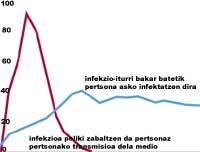Microbiological weapons
Officially biological weapons can only be developed during the research phase, they cannot be used during the war. This is what, for ethical reasons, establishes the International Treaty on the Prohibition of Such Weapons, signed in 1972. According to this agreement, biological weapons cannot be used, but we know that there are several countries and non-governmental groups that have the capacity to do so.
Historical evolution
After the dissolution of the Soviet Union, the present biological weapons, including international missiles plagued with plagues, were released. It was known that bacteria capable of producing plague, tularemia and anthrax pests were manipulated to be resistant to antibiotics. In the 1980s 25,000 Soviet scientists participated in biological weapons development programs. Most of them are currently unemployed, willing to put their knowledge and training at the service of those who pay the best.
It is believed that chemical and biological weapons were also used in the Gulf War. Just in case the soldiers who came there received all the vaccines. After the war, international expert groups had the opportunity to visit the facilities in Iraq. They say that in Iraq there were facilities for the production of biological weapons, with thousands of liters of harmful microorganisms and launchers for their diffusion.
Currently, seventeen countries have official research and development programs for the acquisition of biological weapons. Among them are Syria, Korea, Libya, China, Iran and Iraq. However, apart from these projects, projects or official actions, one knows the number of armed groups capable of creating biological weapons.
Microbiological weapons
Microbiological weapons are weapons made from microorganisms or substances produced by microbes (spores, toxins...). The manufacturing process of these weapons is basically simple, but if they are microorganisms in inadequate technical conditions or by negligence, it can contaminate the producer himself. Depending on the characteristics of the population to attack, many microorganisms can be used as weapons.
The consequences of microbiological weapons produced with current technology are unpredictable and uncontrollable, as they can harm the aggressor and the attacker. According to experts, the advance of genetic engineering will avoid this type of problems in a few years. It seems, therefore, that future microbiological weapons are more selective.
Although the International Covenant on the Prohibition of Biological Weapons mentions ethical reasons, some consider that the real reason for this pact is the impossibility of controlling the effects of biological attacks. However, the limit is expected to be exceeded shortly. As human DNA deciphers, genetic marks that distinguish each human race are believed to be found. In this way, microorganisms can be manipulated using genetic techniques to attack only those with certain characteristics. Therefore, the aggressors would have no risk of contamination.
Most biological weapons invented so far are microbiological weapons, projectiles filled with microorganisms or substances produced by microbes. Through the use of biological weapons, after the selection of the target population and its rapid expansion through the air, it is intended that the majority of the population become ill, much of them die and that the territory attacked be immersed in a health emergency.
The first step in creating biological weapons is obtaining perverse microorganisms. To do this, there are a number of breeding collections that are used to supply existing research laboratories in the world. The second step would be the proliferation of these undesirable microorganisms. This requires only basic scientific instruments, but can pose a risk to those who carry out the process. The last step, the most difficult, is the development of technology for the aerial diffusion of microorganisms. For this purpose projectiles or explosives can be used, but during the explosion the viability of microorganisms and their ability to infection will be lost.
Although they look like science fiction, they are a reality. However, we must distinguish between what fiction is and what reality. The following lines can help in this task.
What microorganisms?

Microorganisms ideal for use as weapons should be the result of a number of characteristics. One of these features is the size, the right size. According to experts, microorganisms should measure about one micrometer. Although most viruses are minor, smallpox virus or Marbug virus are among the largest: They measure between 0.3 and 0.8 micrometers. Most bacteria and spores of bacteria, on the other hand, have a very appropriate size for their spread by air: 1-3 micrometers. The rest of pathogenic microorganisms - fungi, protozoa, etc. - are too large, exceeding 5 micrometers.
In addition to size, the presence of safe microorganisms is of great importance, that is, in the process of making weapons microorganisms should not present added risks. The production of microbiological weapons requires the growth of the selected microorganism. Millions of microorganisms will be obtained from the crop. They collect all of them and then get into the launchers. It is essential to reduce the risk of infection during this process. In bacteria, few species are able to form forms of resistance. These forms, spores, are inert, do not reproduce, but are very resistant and have the ability to survive for many years. Therefore, bacterial spores are optimal for their collection and prevent the reconstruction of bacterial cultures. Also, keep in mind that some bacteria that have been selected to be used in war, such as Bacillus anthracis, only cause mild illness through unexpected contacts.
The microorganism used as a weapon must, in turn, have the capacity to make many people sick. Since the diseases produced by microorganisms are communicable, the introduction of microorganisms in a given population can lead to several cases. In these cases, there is talk of disease. When the outbreak is large, it affects the majority of the population, it speaks of an epidemic.
Depending on the route of transmission of the infection, different types of outbreaks may exist. Sometimes, in a short time, many cases appear at once. In order to produce this type of buds it is essential that the source is unique and current. For example, if drinking water or air is contaminated, many people get sick at the same time. When the source of infection disappeared, the outbreak was over. In other outbreaks, at first few cases appear and the infection is transmitted slowly. Examples of this can be sexually transmitted diseases, such as AIDS. The only solution to eradicate this type of outbreak is to look for a way to protect the population, that is, the vaccine.

To attack the population but that the spread of the infection is limited and controlled, the microorganisms that produce the first types of outbreaks have been selected. Thus, most of the viruses and bacteria listed in the table below can be transmitted to the air or, for example, toxins produced by bacteria, are useful for poisoning drinking water or food.
It also adds the possibility to use as a weapon the dead that can cause microorganisms. Analyzing the data of microbiological weapons outbreaks and extrapolating the experiments with animals, we can calculate the ID50 of each microorganism, the dose necessary to kill half the population. Thus, if spores of Bacillus anthracis are used to attack a population of 100,000 inhabitants, 20,000 spores will be used, while in the case of Brucella melitensis or Francisella tularensis there are enough 1,000 cells.
The last characteristic that microorganisms should have ideal to be used as weapons is the absence of prevention and treatment for them, at least for the attacked population. There are currently no specific treatments for viruses listed in Table 1. In the case of bacteria, however, there are antibiotics suitable for the treatment of anthrax, tularemia, brucellosis, plague and Q fever, but it would not be easy to get antibiotics in intentional giant shoots and immediately treat all infected. With the use of Clostridium toxins antibiotics would be of no use, since the only possibility of controlling toxicity is the antidote and the precise antiserum, and it is very difficult to maintain sufficient antidotes.
In addition to all these characteristics, we must take into account the "contribution" of genetic engineering to this field. In fact, taking advantage of the current possibility of genetic engineering to manipulate genes, the characteristics of these microorganisms can be transformed and existing microbiological weapons "improved", for example through the development of more antibiotic-resistant microorganisms.

Consequences of microbiological warfare
Knowing the characteristics of the ideal microorganisms, once manufactured, only its use remains to the aggressor. However, before use, should you not pay attention to possible effects? It is, but since the influence of microbiological weapons depends on certain variables, it would hardly be known beforehand what will happen next.
Depending on the diffusion technique of the microorganism, the effect can vary considerably. So far, microorganisms have been transported in projectiles and plane explosives, both in smaller bombs and international missiles. Therefore, to know the territory and the population under attack, the characteristics of the projectile,
duration of aggression and size of a microorganism.
The characteristics of the attacked can also condition the action of microorganisms. Some characteristics of the attacked population are difficult to control beforehand: degree of immunity to the microorganism to be used, antibiotic treatments to be taken, possibility of transmission of infection per person, etc. In the case of the baztango virus, being eradicated and having stopped using the vaccine, there is no protection. In most cases, being rare or restricted infections in a few places, the majority of the population lacks antibodies. Health care, management, socio-economic conditions, geographical and demographic factors, etc., should also be taken into account, especially if the ability to respond quickly and appropriately after possible attacks is anticipated.

pests will be returned.
Undoubtedly, the characteristics of the microorganism that most have to do with the impact of aggression are the pathogenesis of the chosen microorganism (pathways or strategies to harm the human being), virulence (ability to get sick and die) and epidemiology. Not all microorganisms have the same pathogenesis, virulence, transmission and infection. When it comes to naturally occurring infections, the pathogenesis, virulence and epidemiology of all these microorganisms are generally known. But when they have spread intentionally not. The example of antrax can be illustrative.
Can microbiological aggressions be prevented?
There is no training to deal with emergencies of similar size to those mentioned in the Antrax example. Therefore, the development and use of biological weapons must be avoided. However, we must be careful to properly diagnose and treat these diseases susceptible to resurgence (anthrax, plague...). To do this, we should look for agile techniques to detect virulent microorganisms in the air. These techniques should be used remotely to analyze any suspicious cloud in a few minutes and, if contagious, take preventive measures as soon as possible. This is not possible with current diagnostic techniques.
On the other hand, one of the most important resources of prevention is education. In case of accident or nuclear attack or chemical spill, programs are created to know how to respond properly and tests are carried out so that the population learns well. The proper response to the pest caused by anthrax, smallpox, or other microbiological weapon would be more difficult due to the lack of development of response programs. Prevention programs have been developed only in some US capitals.
The other option is to use vaccines. Vaccines are suspensions of dead or attenuated microorganisms that specifically increase the immune system to control the infection in case of finding the same microorganism. They are therefore one of the most valuable instruments for the prevention of infectious diseases. To carry out any vaccination it is essential to know the person who will receive the vaccine, since it must take a few weeks to detect the effect of the vaccine. In the case of microbiological weapons this requirement cannot be met, as the entire world population cannot take all vaccines if necessary. However, in case of such aggression, vaccines can be used to reduce the onset and prevent the disease from becoming an epidemic and protect health personnel.
Plague | In the research phase Turalemia* |
Emergency vaccines, in addition to being effective, should be comfortable and cheap. Now on the market you can find vaccines against anthrax, smallpox and plague, in the case of smallpox, and there are others under investigation or improvement such as botulism, Q fever, tularemia or encephalitis. On the other hand, although it seems paradoxical, genetic engineering, the same technology that can be used to create and improve microbiological weapons, can be of great help in the search for new and better vaccines.
The last block of preventive measures would be composed of experts. After the aggression it would be essential to make a diagnosis of the disease as soon as possible. Subsequently, adequate isolation measures and antibiotic treatments should be applied to reduce the number of deaths. In the war surprise is usually an advantage, in the microbiological war ignorance can be a factor in favor of the aggressors. Developing microbiological weapons aim to extend already missing or heavily targeted infectious diseases. Faced with this, experts in infectious diseases should be first class defenses, but unfortunately it is appreciated that this defense will be weak, since health personnel will have no experience to treat this type of infection. Imagine that medical students have not even explained these diseases!
Antrax
Antraxa is an infection caused by the bacteria Bacillus anthracis. This bacteria forms forms of resistance or spores capable of surviving in the environment for a long time (photos). When the land is contaminated with these spores, livestock can become infected and make humans living around livestock sick. Antrax has been one of the greatest plagues of antiquity, also cited in the Bible. In 1660 he killed thousands of humans and animals in Europe, but since 1881 the anthrax vaccine was achieved, it is well controlled and very few cases appear.

In most of them the spores of bacteria enter the skin of man and cause a local infection, mild and curable.
If the anthrax spores are breathed, the issue is much more serious. Bronchial cells—macrophages—swallow spores and carry them inward to the lungs. There spores germinate and proliferate producing and expelling three types of toxins. Toxins kill cells, the infection expands and finally destroy blood vessels and internal organs. If 48 hours after the infection is not treated, 95% of those infected die, without treatment of course all those infected die. It is very rare that these cases occur naturally, since the dose necessary to become infected by the airways is very high -10,000-20,000 spores-. However, when animal hair is full of spores, wool cutters can get sick.
But what would happen after an attack with the antrax sword? If millions of spores between 1 and 2 micrometers of Bacillus anthracis were taken off over a population of 100,000 inhabitants, they would be in the air for about two hours, so that the population can breathe. The appearance of the anthrax would be similar to that of graph 2. Most patients should be hospitalized and treated with antibiotics for a long time, as long as there are medical means to cope with this type of emergency. If there were not, the death toll would be higher than expected. On the other hand, the treatment of 100,000 inhabitants and the days of hospitalization would require between 25 and 500 million dollars.
Microorganisms used
As can be seen in Table 1, substances produced by microorganisms or microbes that can sometimes be used as biological weapons have a wide variety of characteristics, many of which, especially bacteria, have similar or identical characteristics:
- They produce zoonoses. Anthrax, tularemia, brucellosis, etc. are diseases typical of livestock that only sick animals suffer or are in frequent contact with their products (Figure 1).
- Despite the first major outbreaks, health controls currently being performed on livestock make these diseases rare.
- These microorganisms can be transmitted by air.
- When microorganisms enter the skin, the infection can be local, mild and curable, while if they enter the airways the disease can be serious and deadly.
In the case of the Marbug virus the transmission is not fully illuminated, but they know that the deposit is an animal, the monkey. The disease produced by this virus has no treatment and 90% of those infected will die from bleeding.
The viruses that produce encephalitis are found in rodents and in many other animals and humans can collect them through mosquitoes. These transmitters are very specific, so the disease is limited to where the transmitting species lives.
The Baztanga virus has no deposit in animals, is a human virus and, thanks to vaccines, is currently missing.
Microorganism Disease Treatment Resistance Size Transmissionperfringes





